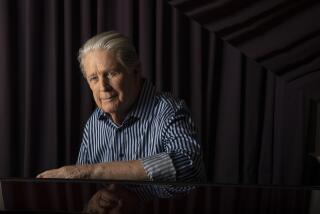SUMMER READING ISSUE : It Was a Rough-and-Tumble Ride but, Boy, Could He Sing : MEMOIR : I LIVED TO TELL IT ALL,<i> By George Jones with Tom Carter (Random House: $23; 333 pp.)</i>
- Share via
“If we could all sound like we wanted to, we’d all sound like George Jones,” Waylon Jennings once said.
In “I Lived to Tell It All,” his autobiography with Tom Carter, Jones describes the barroom fights, missed shows, shattered relationships and drug abuse that came with the title of the greatest country singer in the world.
Jones’ upbringing in rural southeast Texas, where his father lumbered, farmed and sold bootleg whiskey, closely parallels that of Hank Williams, Jones’ lifelong inspiration, and like Williams he fought a lifelong battle with drugs and alcohol, a battle Williams lost at an early age.
Singing at 14 on the streets of Beaumont, Texas, Jones was soon in the beer joints and honky-tonks, showing a taste for liquor and a temper when he drank that would lead him into fights all over the world.
Imitating his heroes--Williams, Roy Acuff and Lefty Frizzell--led to radio shows and Starday Records. At his first recording session, they had to tell him: “The world already has a Hank, Roy and Lefty. . . . Do you think you could sing like George Jones?” He could and did and soon developed a voice and style so rich and complex that only recently has anyone tried to imitate it, a voice so pure and so haunting it could tear the heart out of grown men and bring them to tears.
There followed one of the most successful country music careers ever--hundreds of albums recorded, dozens of hit songs and performances all over the world. But by the late 1970s, after his marriage and divorce from fellow country star Tammy Wynette, Jones was wasted. He stayed up days at a time, running on booze and cocaine, collapsing from exhaustion, only to wake up and do it all again.
He blew off so many shows for so long that promoters began advertising Jones without contacting him or his agency, knowing that they could sell tickets and then blame him for not showing, saying he was probably drunk somewhere. “No show Jones” became his nickname.
As Jones tells it, he fell in with crooked management who learned to work this scheme. They’d book him on several engagements the same day, knowing they could blame him for not showing and keep the advances. Jones claims this same management eventually conspired with his drug suppliers to keep him supplied with cocaine, taking out a life insurance policy so they could collect whether he lived or died.
Jones’ drug and alcohol addiction was so bad by now he didn’t know what he was doing. He was being paid in cocaine for the few performances he did and his behavior was erratic and often violent. He shot off guns on tour buses and flopped wherever he happened to be. A man who had earned millions of dollars was living in his car, hearing voices and talking like a duck.
Jones can write this book because he has put his life and his career back together and put drugs and alcohol behind him. He credits his wife, Nancy, with saving him. The escape he describes--from his drug suppliers and crooked managers--is truly frightening.
The level of consistency over the thousands of songs Jones has recorded, even through the bad years, is amazing. His choice of material and his songwriting, when he still wrote, have always been among the best. Songs like “The Grand Tour” and “A Good Year for the Roses” are as haunting as any of the best Southern literature.
Sadly, he reveals little about this, explaining late in the book that he leaves song selection to his producers, and singing, he says, is just what he does.
Sorry, I don’t buy it. A body of work that defines country music takes a little more effort. But I imagine Williams would have had little to say about the creative process, too, preferring to make light of it with some good ol’ country charm.
What “I Lived to Tell It All” offers is a rough-and-tumble ride through the backwoods, when hillbilly bands rode six to a car with instruments and no a/c, when country stars played endless successions of one-nighters in thousands of towns and the only way to relieve the pressure was booze and practical jokes.
It’s Mick Jagger in a headlock for blowing up one of the Jones Boys’ amplifiers in Austin in 1965. It’s the “Possum” (Jones’ nickname) grabbing Porter Waggoner by the crotch in the men’s room of the Ryman Auditorium, accusing him of having an affair with Wynette and watching him jump.
Jones does a lot of apologizing for his sins to his friends and his fans, and he seems genuinely sorry and embarrassed by the things he did, the people he hurt and the shows he missed all the years he was under the influence.
But for a lot of us all he has to do is open up his mouth and sing--and all is forgiven. As Gram Parsons said, he’s “The King of Broken Hearts.”
More to Read
Sign up for our Book Club newsletter
Get the latest news, events and more from the Los Angeles Times Book Club, and help us get L.A. reading and talking.
You may occasionally receive promotional content from the Los Angeles Times.







